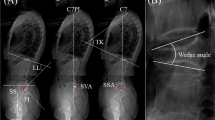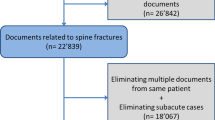Abstract
The long-term outcome of thoracic and lumbar fractures in late adolescence is sparsely described and it is unclear whether a fractured vertebral body in these years, as in young children, can be resituated in height. The purpose of this study was to in late adolescence determine the incidence, the long-term outcome and the modelling capacity in fractures of the thoracic and lumbar region. The incidence of vertebral fractures 1950–1971 in individuals aged 16–18 years was through the radiological archives evaluated in a city cohort of 228,878 citizens, of whom 13,893 were aged 16–18. A follow-up, 27–47 years after the injury, including subjective, objective and radiological evaluation was conducted in 18 boys and 5 girls. Twenty-nine boys and 11 girls were registered with a thoracic or lumbar vertebral fracture during the study period conferring an annual incidence of 0.14‰. Of the 23 individuals that attended the follow-up, 14 had one-column compression fractures, one a Denis type A, six a Denis type B, one a Denis type D and one a Chance fracture. At injury, one had a partial paresis in one leg and one developed a transient paraparesis during the first week. All were treated non-operatively. At follow-up, 18 individuals had no complaints while 5 had occasional back pain, 20 were classified as Frankel E and 3 as Frankel D. The radiographic ratio of anterior height to posterior height of the fractured vertebral body was unchanged during the study period. Thoracic and lumbar vertebral fractures in late adolescence with no or minor neurological deficits have a predominantly favourable long-term outcome, even if no modelling capacity of the fractured vertebral body remains in late adolescence.



Similar content being viewed by others
References
Bass S, Delmas PD, Pearce G, Hendrich E, Tabensky A, Seeman E (1999) The differing tempo of growth in bone size, mass, and density in girls is region-specific. J Clin Invest 104:795–804
Chan DP, Seng NK, Kaan KT (1993) Nonoperative treatment in burst fractures of the lumbar spine (L2–L5) without neurologic deficits. Spine 18:320–325
Chow GH, Nelson BJ, Gebhard JS, Brugman JL, Brown CW, Donaldson DH (1996) Functional outcome of thoracolumbar burst fractures managed with hyperextension casting or bracing and early mobilization. Spine 21:2170–2175
Clark P, Letts M (2001) Trauma to the thoracic and lumbar spine in the adolescent. Can J Surg 44:337–345
Cooper C, Dennison EM, Leufkens HG, Bishop N, van Staa TP (2004) Epidemiology of childhood fractures in Britain: a study using the general practice research database. J Bone Miner Res 19:1976–1981
Dai LY (2001) Remodeling of the spinal canal after thoracolumbar burst fractures. Clin Orthop Relat Res 382:119–123
Denis F, Armstrong GW, Searls K, Matta L (1984) Acute thoracolumbar burst fractures in the absence of neurologic deficit. A comparison between operative and nonoperative treatment. Clin Orthop Relat Res 189:142–149
Fairbank JC, Couper J, Davies JB, O’Brien JP (1980) The Oswestry low back pain disability questionnaire. Physiotherapy 66:271–273
Frankel HL, Hancock DO, Hyslop G, Melzak J, Michaelis LS, Ungar GH, Vernon JD, Walsh JJ (1969) The value of postural reduction in the initial management of closed injuries of the spine with paraplegia and tetraplegia. I. Paraplegia 7:179–192
Harrison DE, Cailliet R, Harrison DD, Janik TJ, Holland B (2001) Reliability of centroid, Cobb, and Harrison posterior tangent methods: which to choose for analysis of thoracic kyphosis. Spine 26:E227–E234
Hasserius R, Redlund-Johnell I, Mellstrom D, Johansson C, Nilsson BE, Johnell O (2001) Vertebral deformation in urban Swedish men and women: prevalence based on 797 subjects. Acta Orthop Scand 72:273–278
Hinck VC, Hopkins CE, Clark WM (1965) Sagittal diameter of the lumbar spinal canal in children and adults. Radiology 85(5):929–937
Horal J, Nachemson A, Scheller S (1972) Clinical and radiological long term follow-up of vertebral fractures in children. Acta Orthop Scand 43:491–503
Hubbard DD (1974) Injuries of the spine in children and adolescents. Clin Orthop Relat Res 100:56–65
Jonsson B (1993) Life style and fracture risk. In: Orthopaedic department. University of Lund, Lund
Kanis JA, Johnell O, Oden A, Sembo I, Redlund-Johnell I, Dawson A, De Laet C, Jonsson B (2000) Long-term risk of osteoporotic fracture in Malmo. Osteoporos Int 11:669–674
Karlsson MK, Hasserius R, Sundgren P, Redlund-Johnell I, Ohlin A (1997) Remodeling of the spinal canal deformed by trauma. J Spinal Disord 10:157–161
Kerttula LI, Serlo WS, Tervonen OA, Paakko EL, Vanharanta HV (2000) Post-traumatic findings of the spine after earlier vertebral fracture in young patients: clinical and MRI study. Spine 25:1104–1108
Kraemer WJ, Schemitsch EH, Lever J, McBroom RJ, McKee MD, Waddell JP, (1996) Functional outcome of thoracolumbar burst fractures without neurological deficit. J Orthop Trauma 10:541–544
Landin L (1983) Fracture pattern in children. In: Orthopaedic department. University of Lund, Lund
Magnus KK, Anders M, Ralph H, Jack B, Caroline K, Acke O (2003) A modeling capacity of vertebral fractures exists during growth—an up to 47-year follow-up. Spine 28:2087–2092
McPhee IB (1981) Spinal fractures and dislocations in children and adolescents. Spine 6:533–537
Melton LJ 3rd, Atkinson EJ, Cooper C, O’Fallon WM, Riggs BL (1999) Vertebral fractures predict subsequent fractures. Osteoporos Int 10:214–221
Mollenhoff G, Walz M, Muhr G (1993) [Compensation behavior after fractures of the thoracic and lumbar spine in children and adolescents]. Chirurg 64:948–952
Mumford J, Weinstein JN, Spratt KF, Goel VK (1993) Thoracolumbar burst fractures. The clinical efficacy and outcome of nonoperative management. Spine 18:955–970
Parisini P, Di Silvestre M, Greggi T (2002) Treatment of spinal fractures in children and adolescents: long-term results in 44 patients. Spine 27:1989–1994
SBU (2000) Neck pain, back pain. The Swedish council on technology assessment in health care. In: SBU report no 145. Stockholm, Sweden
Shen WJ, Shen YS (1999) Nonsurgical treatment of three-column thoracolumbar junction burst fractures without neurologic deficit. Spine 24:412–415
Singer BR (1995) The functional prognosis of thoracolumbar vertebrae fractures without neurological deficit: a long-term follow-up study of British Army personnel. Injury 26:519–521
Singer BR, McLauchlan GJ, Robinson CM, Christie J (1998) Epidemiology of fractures in 15,000 adults: the influence of age and gender. J Bone Joint Surg Br 80:243–248
Weinstein JN, Collalto P, Lehmann TR (1987) Long-term follow-up of nonoperatively treated thoracolumbar spine fractures. J Orthop Trauma 1:152–159
Acknowledgement
Financial support was obtained from the Palsson, Wiberg, Sven Jerring and the Malmo and Lund University Foundations. The study was approved by The Ethical Committee at the University of Lund, Sweden.
Author information
Authors and Affiliations
Corresponding author
Rights and permissions
About this article
Cite this article
Moller, A., Hasserius, R., Besjakov, J. et al. Vertebral fractures in late adolescence: a 27 to 47-year follow-up. Eur Spine J 15, 1247–1254 (2006). https://doi.org/10.1007/s00586-005-0043-2
Received:
Revised:
Accepted:
Published:
Issue Date:
DOI: https://doi.org/10.1007/s00586-005-0043-2




